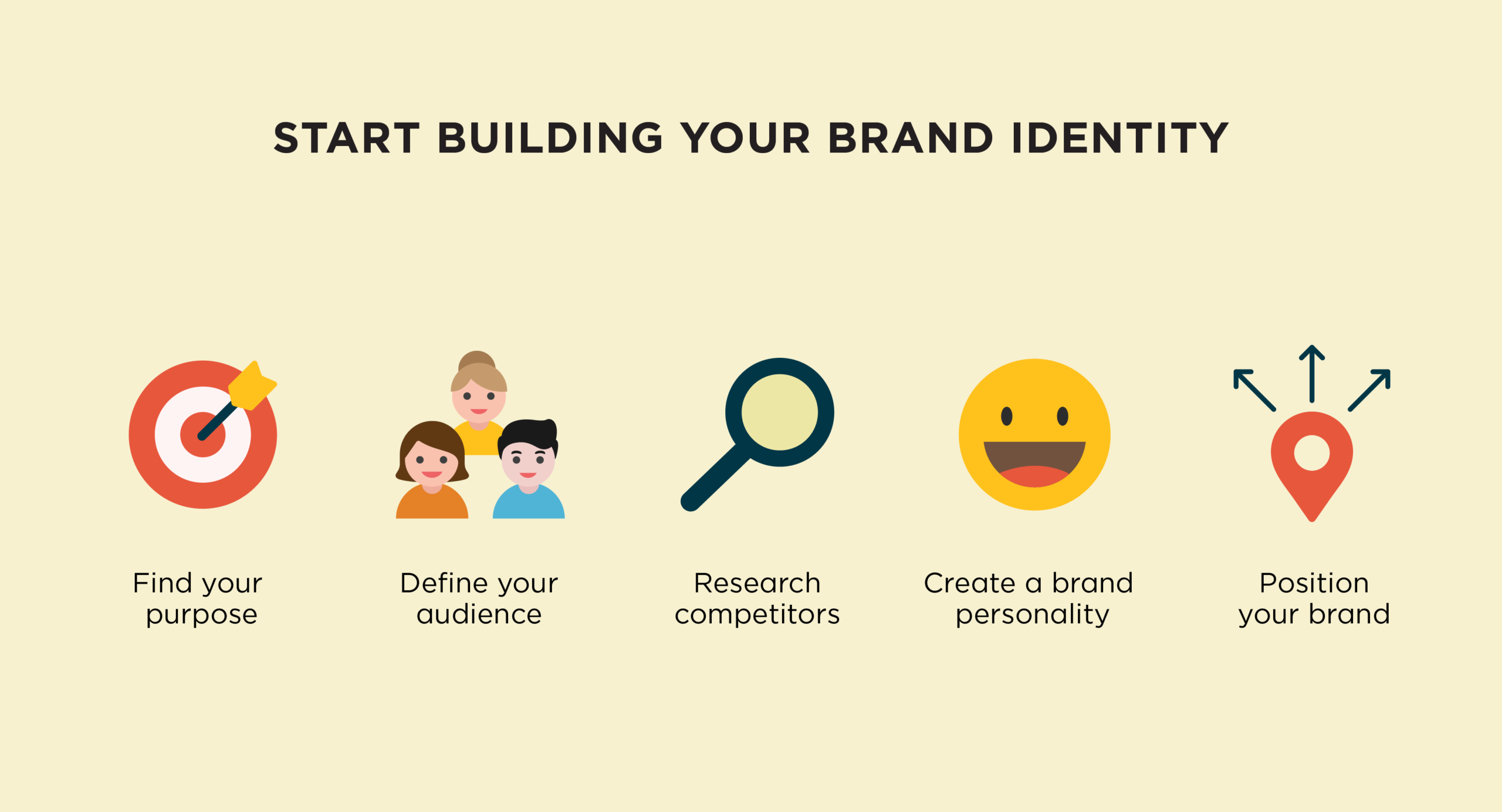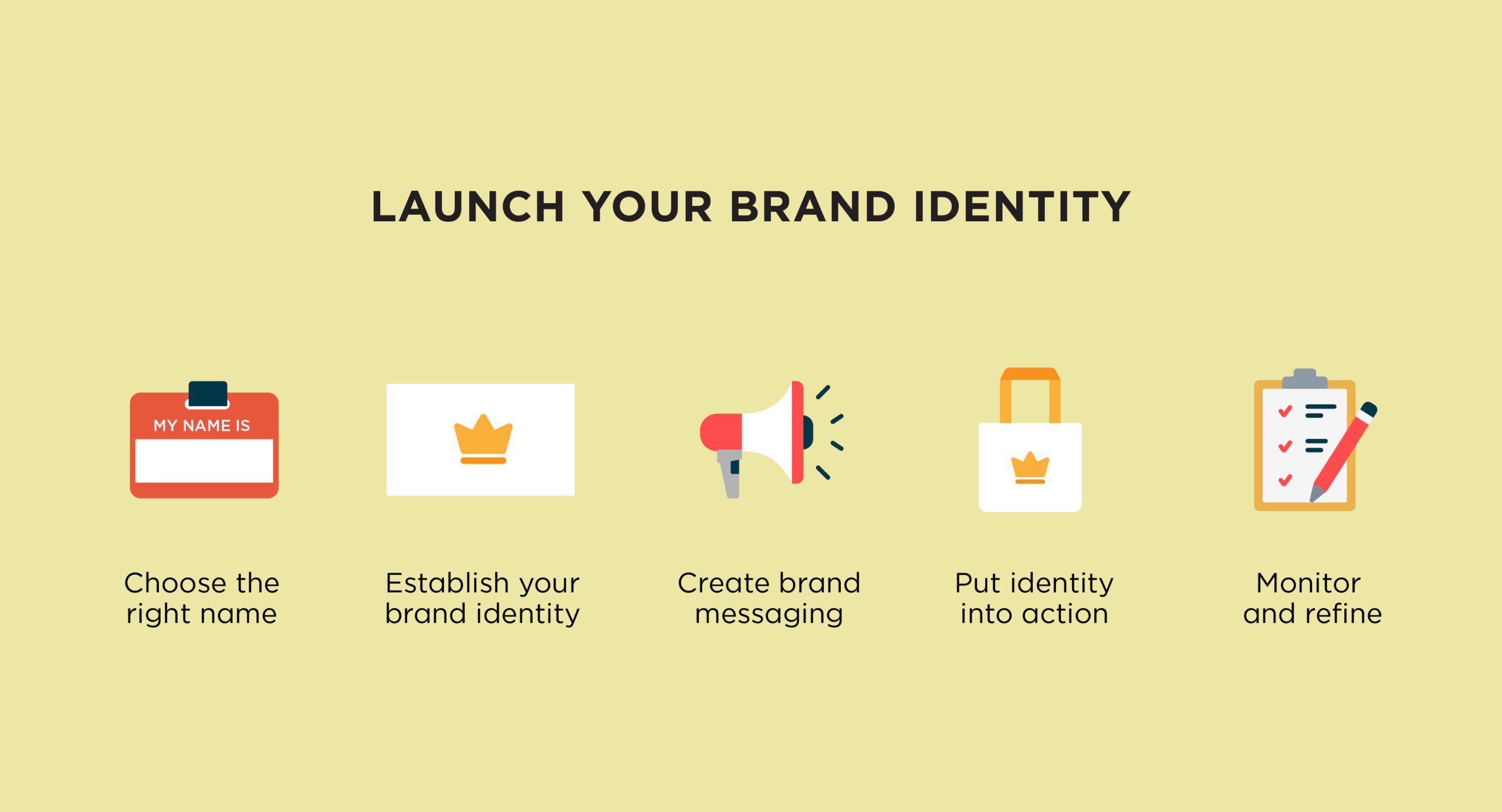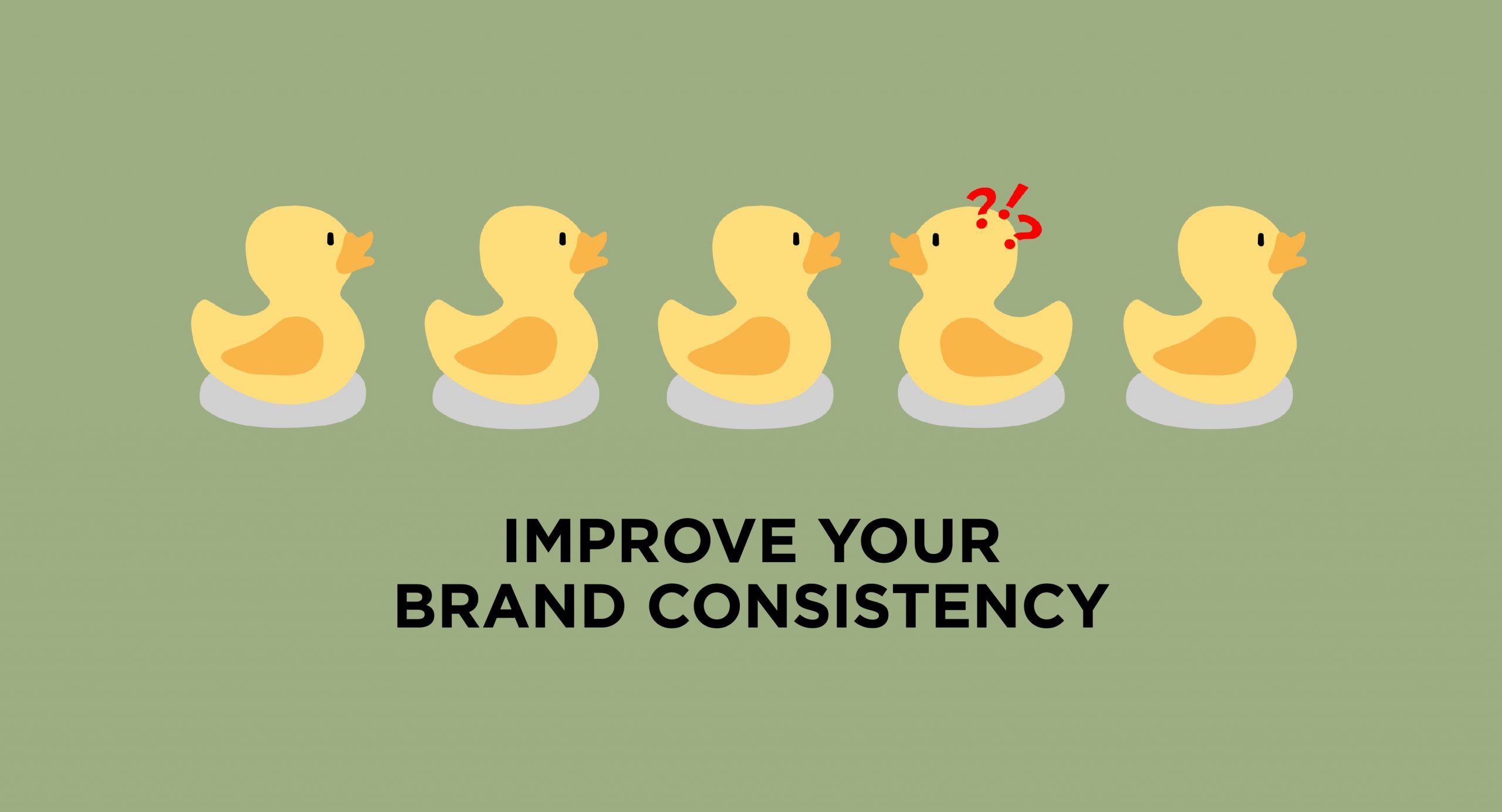BRANDING
How To Create A Successful Brand Identity: A Step-By-Step Guide
To build your brand identity, you need to define your purpose, target audience, brand personality, brand positioning, brand name, tagline, visual identity and messaging, then implement it consistently across all touchpoints and monitor its effectiveness over time.
It’s a complex task, but building a strong brand identity is essential for any company that wants to stand out in today’s cluttered and competitive marketplace. Let’s step you through our process for creating a successful brand identity to help your business thrive.
What is brand identity?
A brand’s identity is more than just a logo or a tagline; it is a complete visual and verbal representation of your brand’s personality, values, and purpose.
Your brand identity is what makes you stand out. Our brand identity process helps you systematically consider all the important factors that work together to make up your brand identity.
Following this approach will help you strategically craft a differentiated brand identity, position your brand as a unique and compelling choice in the marketplace, attract customers, build loyalty, and drive sales while leaving a lasting impression that sets you apart from your competition.
Brand identity process
Here are the ten steps you can take to build and manage your brand identity:
- Determine your brand’s purpose.
- Define your target audience.
- Research your competitors.
- Create a personality for your brand.
- Write a brand positioning statement.
- Choose a name and tagline.
- Establish your visual identity.
- Create brand messaging.
- Put your brand identity into action.
- Monitor and refine your brand identity.

1. Determine your brand’s purpose
Brand purpose is the impact you want to make in the world.
Defining your brand’s purpose is the first step in developing a strong brand identity. Understanding and documenting your ‘why’ is critical because it serves as a guiding force for your decisions, actions, and overall strategy.
Your purpose is your reason for existence and should represent the deeper meaning and values that drive your business. It should embody the authentic and inspiring reason behind why you do what you do. This foundation will serve as a guidepost for all future branding efforts, ensuring that your messaging, visual identity, and marketing materials are consistent with your purpose.
You’ll need to undertake some deep introspection to define your brand purpose. Start by contemplating your brand’s unique story, the problem you solve, and the value you bring to customers’ lives. Reflect on your brand’s vision and the positive change you want to create.
For instance, a sustainable fashion brand’s purpose might be to promote ethical practices in the fashion industry, empower small-scale producers, and reduce environmental impact. By integrating fair-trade sourcing, transparent supply chains, and eco-friendly materials, they live their purpose and inspire customers who value conscious fashion choices.

2. Define your target audience
Your target audience is a specific group of people you aim to reach and serve.
Identifying your target audience is essential in developing a solid brand identity. You can tailor your branding strategy to better resonate with them if you understand their needs, preferences, and behaviours. Start by conducting market research to analyse demographics, psychographics, and consumer behaviors.
Dig deep into their needs, aspirations, pain points, and preferences. You can create detailed buyer personas that represent your ideal customers by gathering insights through surveys, interviews, and data analysis. These personas provide a clear picture of who you’re targeting, enabling you to tailor your messaging, products, and experiences to resonate with them on a deeper level.
For example, if you are a fitness apparel brand targeting health-conscious millennials, your target audience might be active individuals aged 25-35 who prioritise wellness, value sustainability, and seek unique, functional workout gear.
By understanding your audience, you can create marketing campaigns that emphasise eco-friendly materials. By honing in on your target audience’s desires and aspirations, you can effectively connect with them, build brand loyalty, and drive sales.
3. Research your competitors
Researching your competitors when creating your brand identity is a crucial step that can provide valuable insights and a competitive edge in the market. By understanding what your competitors offer and how they position themselves, you can identify opportunities to differentiate your brand and create a unique value proposition that resonates with your target audience.
To begin your competitor research, identify key industry players who target a similar audience. Explore their websites, social media profiles, and marketing materials to understand their brand messaging, services offered, and overall positioning. Take note of their strengths, weaknesses, and areas where you can outperform them.
Next, analyse their client testimonials and online reviews to uncover what customers appreciate about their services and where there may be room for improvement. Pay attention to common pain points or gaps in their offerings that you can address with your brand.
For instance, let’s say you’re a financial advisor targeting young professionals. Your research uncovers that your competitors focus on offering investment advice but customers are just as interested in learning how to make sound financial decisions.
You can fill that gap in the market by differentiating yourself and positioning your brand as an advisor who not only provides investment guidance but also offers comprehensive financial education resources like webinars, workshops, and online tools to empower customers to make informed financial decisions.
4. Create a personality for your brand
Brand personality is the human-like traits and characteristics that your brand embodies.
Creating a memorable and impactful brand identity requires the development of a strong brand personality. It distinguishes you from the competition and makes your brand more relatable to your target audience.
To create your brand personality, identify the key personality traits consistent with your brand’s purpose. Consider the emotions you want your brand to elicit and the personality traits that will assist you in achieving that. For example, if your brand is about innovation and pushing boundaries, you could embody a daring, bold and unapologetic personality.
The tone of voice you use will bring your brand personality to life. Spend time creating a description of your tone of voice including examples so that everyone who writes on behalf of the company knows how to bring the brand personality to life in communication piece they create for the brand.
For example, our daring, bold and unapologetic brand may announce an upcoming sale on social media like this: ‘Get ready for the most epic sale event of the year! Brace yourself for jaw-dropping discounts and unbeatable deals. It’s time to live boldly, shop fearlessly, and unleash your inner trailblazer.’
Consider your brand as a person with distinct personality traits, likes, dislikes, and quirks. You can give your brand persona a name and backstory to make it more relatable and engaging. Your brand persona should guide your communication strategy, ensuring your messaging and tone are consistent across all channels.
5. Write a brand positioning statement
A brand positioning statement succinctly defines how a brand differentiates itself from competitors.
To create a brand positioning statement:
- Identify what makes you different.
- Consider the benefits and value your brand offers and how it fulfills the specific needs of your audience.
- Distill these elements into a clear and concise statement that encapsulates your brand’s unique position in the market.
Here is a template and a completed example you can use as inspiration for creating your brand positioning statement:
- Template: For [insert your target market] looking for [product, service or problem you solve], our [product/service] is a [name the category] that does [the key problem-solving capability]. Unlike [primary alternative], we [key differentiator].
- Completed example: For discerning home renovators seeking innovative design solutions, our architectural firm offers a visionary approach to transforming spaces. Our designs are a fusion of art and functionality, redefining the category of residential architecture. Unlike other architects, we seamlessly integrate sustainability principles into our designs, creating eco-friendly and energy-efficient homes that inspire and endure.

6. Choose a name and tagline
Your brand name and tagline are vital in shaping your brand identity and leaving a lasting impression on your target audience. Your brand name must be memorable and evoke your brand’s essence. It should reflect your brand’s purpose, personality, positioning and appeal to your target audience. Similarly, if you choose to have a tagline, it should be a concise, catchy statement that quickly communicates your brand’s value.
Consider your brand’s core values, target audience, and competitive landscape to create a compelling brand name and tagline. Brainstorm words, concepts, and associations that align with your brand’s identity and positioning. Remember to aim for clarity, simplicity, and relevance to your industry.
Think about using variations on your name, use something descriptive or invent a new word. Test different options with your target audience to gauge their response and refine your choices.
A great brand name and tagline example is IMAX, which used a combination of the words ‘image’ and ‘maximum’ for their brand. Their tagline ‘Think Big’ reinforces their brand identity, encouraging audiences to aspire to grander experiences and embrace the immersive and awe-inspiring world of big screen theatres.
7. Establish your visual identity
Your visual identity consists of your logo, colour palette, typography, and other graphic elements that represent and differentiate your brand.
Your logo and visual identity play a massive role in creating a strong and memorable brand identity. They are the visual elements that convey the essence and brand personality to your target audience. A well-designed logo and consistent visual identity can make a lasting impression and lead to better business performance.
The first step in developing your visual identity is creating a logo and selecting your colour palette. Your logo is the focal point of your visual identity and should be easily identifiable and memorable. The colours you choose for your brand can significantly impact how your audience perceives it. Colours can convey emotions and create a certain mood, so choosing colours that align with your brand’s personality and values is essential.
Your visual identity should include typography and other graphic elements such as patterns, icons and imagery in addition to your logo and colour palette. The typography you choose should be easy to read and reflect the personality and tone of your brand. It is also critical to select versatile typography that can be used in various mediums, such as print and digital.
There are a vast array of options for logo and colour palette design. You can try a DIY approach using intuitive (and sometimes free) online tools, but these have limitations in creativity, originality and their ability to represent your personality visually.
You could work with a graphic designer or engage a professional brand design agency with the expertise to help you clarify your brand’s purpose, positioning, values and personality and then bring it to life.
An excellent example of a brand that understands the importance of a strong logo and visual identity is Nike. The iconic Nike ‘swoosh’ logo represents movement and athleticism. It is instantly recognisable and serves as a symbol of their commitment to empowerment.
Nike’s visual identity extends beyond the logo, incorporating consistent use of bold typography, dynamic imagery, and a distinct color palette, creating a cohesive and powerful brand presence across all channels.

8. Create brand messaging
Brand messaging is a set of words and phrases that communicate your unique value proposition and personality.
Developing your brand messaging is a critical part of creating your brand identity. Your communication needs to be consistent, clear, and genuine. It should convey your brand’s distinct personality and values while connecting with your target audience, and to do this, you need to have decided ahead of time what phrases and words best achieve these goals.
An excellent way to do this is to create a messaging hierarchy, which is the order that you want to convey your brand’s messaging. For example, a key messaging hierarchy for a sustainable fashion brand could include the following levels:
- Primary message: Fashion that cares for the planet.
- Supporting message 1: Sustainably sourced materials and ethical production practices.
- Supporting message 2: Stylish designs that don’t compromise on quality.
- Supporting message 3: Join the sustainable fashion movement.
- Call-to-action: Shop our eco-friendly collection and make a positive impact.
9. Put your brand identity into action
Once you have developed your brand identity, you can implement it across your website, social media platforms, advertising, and other physical and marketing materials. Building a strong brand identity and ensuring your messaging is memorable and resonates with your target audience require consistency.
This is where your brand style guide is useful. A brand style guide is a document that specifies how your brand should be represented across all channels. It explains how to correctly use your logo, colour palette, typography, and other visual elements. It also includes information about your brand’s messaging hierarchy, tone of voice, and specific words or phrases to use or avoid.
Every customer touchpoint should reflect your brand’s identity, from your website to social media pages to business cards, uniforms, signage and brochures. Ensure consistency across all channels by having a brand guide that helps to consistently maintain your brand’s identity.
10. Monitor and refine your brand identity
Developing a successful brand identity is an ongoing process. After establishing and implementing your brand identity across all channels, you need to monitor it over time. Your business and target audience may evolve, and your brand may need to adapt. You might need to improve your messaging, change your visual identity, or even redefine your brand’s purpose.
Monitoring your brand identity with your target audience helps assess its effectiveness and make any necessary changes. You could undertake surveys, focus groups, or other market research, or run various marketing campaigns to see what brings the best results. Gathering data and feedback can provide valuable insights into how customers perceive your brand and what changes may be required.
Ready to create your brand identity?
A strong brand identity builds credibility and customer trust, increasing brand recognition and loyalty. Take the time to invest in your brand identity, and your company will thrive.
By following the steps outlined in this guide, you can try your hand at developing a brand identity for your business, although many companies outsource this important task to branding experts. If you’d like to see how this might work for your business, get in touch for a free introductory chat.













